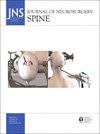Do class III obese patients achieve similar outcomes and satisfaction to nonobese patients following surgery for cervical myelopathy? A QOD study.
IF 2.9
2区 医学
Q2 CLINICAL NEUROLOGY
引用次数: 0
Abstract
OBJECTIVE The aim of this study was to compare the rate of achievement of the minimal clinically important difference (MCID) in patient-reported outcomes (PROs) and satisfaction between cervical spondylotic myelopathy (CSM) patients with and without class III obesity who underwent surgery. METHODS The authors analyzed patients from the 14 highest-enrolling sites in the prospective Quality Outcomes Database CSM cohort. Patients were dichotomized based on whether or not they were obese (class III, BMI ≥ 35 kg/m2). PROs including visual analog scale (VAS) neck and arm pain, Neck Disability Index (NDI), modified Japanese Orthopaedic Association (mJOA), EQ-5D, and North American Spine Society patient satisfaction scores were collected at baseline and 24 months after cervical spine surgery. RESULTS Of the 1141 patients with CSM who underwent surgery, 230 (20.2%) were obese and 911 (79.8%) were not. The 24-month follow-up rate was 87.4% for PROs. Patients who were obese were younger (58.1 ± 12.1 years vs 61.2 ± 11.6 years, p = 0.001), more frequently female (57.4% vs 44.9%, p = 0.001), and African American (22.6% vs 13.4%, p = 0.002) and had a lower education level (high school or less: 49.1% vs 40.8%, p = 0.002) and a higher American Society of Anesthesiologists grade (2.7 ± 0.5 vs 2.5 ± 0.6, p < 0.001). Clinically at baseline, the obese group had worse neck pain (VAS score: 5.7 ± 3.2 vs 5.1 ± 3.3), arm pain (VAS score: 5.4 ± 3.5 vs 4.8 ± 3.5), disability (NDI score: 42.7 ± 20.4 vs 37.4 ± 20.7), quality of life (EQ-5D score: 0.54 ± 0.22 vs 0.56 ± 0.22), and function (mJOA score: 11.6 ± 2.8 vs 12.2 ± 2.8) (all p < 0.05). At the 24-month follow-up, however, there was no difference in the change in PROs between the two groups. Even after accounting for relevant covariates, no significant difference in achievement of MCID and satisfaction was observed between the two groups at 24 months. CONCLUSIONS Despite the class III obese group having worse baseline clinical presentations, the two cohorts achieved similar rates of satisfaction and MCID in PROs. Class III obesity should not preclude and/or delay surgical management for patients who would otherwise benefit from surgery for CSM.颈椎病手术后,III 级肥胖患者的疗效和满意度是否与非肥胖患者相似?一项 QOD 研究。
目的:本研究旨在比较接受手术治疗的颈椎病(CSM)患者在患者报告结果(PROs)和满意度方面的最小临床重要性差异(MCID)的达标率。方法:作者分析了前瞻性质量结果数据库CSM队列中注册人数最多的14个研究机构的患者。根据患者是否肥胖(III 级,BMI ≥ 35 kg/m2)对其进行二分。在基线和颈椎手术后24个月收集了包括视觉模拟量表(VAS)颈部和手臂疼痛、颈部残疾指数(NDI)、改良日本骨科协会(mJOA)、EQ-5D和北美脊柱协会患者满意度评分在内的PROs。24个月的随访中,PROs的随访率为87.4%。肥胖患者更年轻(58.1 ± 12.1 岁 vs 61.2 ± 11.6 岁,P = 0.001)、更多为女性(57.4% vs 44.9%,P = 0.001)、非裔美国人(22.6% vs 13.4%,P = 0.002),教育程度较低(高中或以下:49.1% vs 40.8%,P = 0.002),美国麻醉医师协会等级较高(2.7 ± 0.5 vs 2.5 ± 0.6,P < 0.001)。在临床基线上,肥胖组的颈部疼痛(VAS 评分:5.7 ± 3.2 vs 5.1 ± 3.3)、手臂疼痛(VAS 评分:5.4 ± 3.5 vs 4.8 ± 3.5)、残疾(NDI 评分:42.7 ± 20.4 vs 37.4 ± 20.7)、生活质量(EQ-5D 评分:0.54 ± 0.22 vs 0.56 ± 0.22)和功能(mJOA 评分:11.6 ± 2.8 vs 12.2 ± 2.8)(均 p < 0.05)。然而,在 24 个月的随访中,两组患者的 PROs 变化没有差异。结论尽管III级肥胖组的基线临床表现较差,但两组患者的满意度和PROs的MCID达到了相似的水平。III度肥胖不应该排除和/或延迟对CSM患者的手术治疗,否则这些患者会从手术中获益。
本文章由计算机程序翻译,如有差异,请以英文原文为准。
求助全文
约1分钟内获得全文
求助全文
来源期刊

Journal of neurosurgery. Spine
医学-临床神经学
CiteScore
5.10
自引率
10.70%
发文量
396
审稿时长
6 months
期刊介绍:
Primarily publish original works in neurosurgery but also include studies in clinical neurophysiology, organic neurology, ophthalmology, radiology, pathology, and molecular biology.
 求助内容:
求助内容: 应助结果提醒方式:
应助结果提醒方式:


